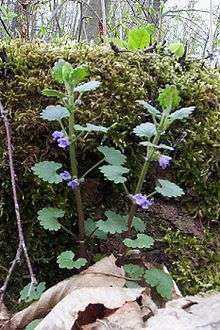Glechoma
| Glechoma | |
|---|---|
 | |
| Glechoma hederacea | |
| Scientific classification | |
| Kingdom: | Plantae |
| (unranked): | Angiosperms |
| (unranked): | Eudicots |
| (unranked): | Asterids |
| Order: | Lamiales |
| Family: | Lamiaceae |
| Genus: | Glechoma L. |
| Synonyms[1] | |
| |
Glechoma is a genus of flowering plants in the mint family, Lamiaceae, first described for modern science in 1753. It is distributed in northern Asia and Europe with a center of diversity in Asia, especially China. One species is naturalized in New Zealand and in North America.[1][2][3][4]
These plants are perennial herbs with stolons. The stems are prostrate or upright and bear leaf blades on long petioles. The inflorescences arising from the leaf axils have two to many flowers. The tubular corolla has two lobed lips,[3] and is generally blue-violet.[2] The genus is closely related to Marmoritis.[2]
- Species
- [1]
- Glechoma biondiana (Diels) C.Y.Wu & C.Chen - Gansu, Hebei, Henan, Hubei, Shaanxi, Sichuan
- Glechoma grandis (A.Gray) Kuprianova - Japan, Taiwan, Jiangsu
- Glechoma hederacea L. – ground-ivy, creeping charlie - much of Europe, much of Russia, Central Asia, Xinjiang; naturalized in New Zealand and North America
- Glechoma hirsuta Waldst. & Kit. - eastern and southeastern Europe
- Glechoma longituba (Nakai) Kuprian. - Vietnam, Korea, eastern + central China, Russian Far East (Amur, Primorye)
- Glechoma × pannonica Borbás - eastern Russia, Ukraine, Hungary, Baltic Republics (G. hederacea × G. hirsuta)
- Glechoma sardoa Halácsy & Wettst. - Sardinia
- Glechoma sinograndis C.Y.Wu - Yunnan
Ecology
Insects found on Glechoma include the carpenter bee Xylocopa sinensis, which robs nectar from G. longituba.[5]
References
- 1 2 3 Kew World Checklist of Selected Plant Families
- 1 2 3 Jang, T. and S. Hong. (2010). Comparative pollen morphology of Glechoma and Marmoritis (Nepetinae, Lamiaceae). Journal of Systematics and Evolution 48(6), 464-73.
- 1 2 Flora of China Vol. 17 Page 118 活血丹属 huo xue dan shu Glechoma Linnaeus, Sp. Pl. 2: 578. 1753.
- ↑ Biota of North America Program 2013 county distribution map
- ↑ Zhang, Y. W., et al. (2007). Nectar robbing of a carpenter bee and its effects on the reproductive fitness of Glechoma longituba (Lamiaceae). Plant Ecology 193(1), 1-13.
External links
This article is issued from Wikipedia - version of the Monday, February 15, 2016. The text is available under the Creative Commons Attribution/Share Alike but additional terms may apply for the media files.